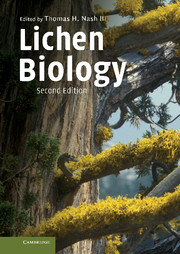Book contents
- Frontmatter
- Contents
- List of contributors
- Preface
- 1 Introduction
- 2 Photobionts
- 3 Mycobionts
- 4 Thallus morphology and anatomy
- 5 Morphogenesis
- 6 Sexual reproduction in lichen-forming ascomycetes
- 7 Biochemistry and secondary metabolites
- 8 Stress physiology and the symbiosis
- 9 Physiological ecology of carbon dioxide exchange
- 10 The carbon economy of lichens
- 11 Nitrogen, its metabolism and potential contribution to ecosystems
- 12 Nutrients, elemental accumulation, and mineral cycling
- 13 Individuals and populations of lichens
- 14 Environmental role of lichens
- 15 Lichen sensitivity to air pollution
- 16 Lichen biogeography
- 17 Systematics of lichenized fungi
- Appendix: Culture methods for lichens and lichen symbionts
- References
- Taxon index
- Subject index
5 - Morphogenesis
Published online by Cambridge University Press: 05 September 2012
- Frontmatter
- Contents
- List of contributors
- Preface
- 1 Introduction
- 2 Photobionts
- 3 Mycobionts
- 4 Thallus morphology and anatomy
- 5 Morphogenesis
- 6 Sexual reproduction in lichen-forming ascomycetes
- 7 Biochemistry and secondary metabolites
- 8 Stress physiology and the symbiosis
- 9 Physiological ecology of carbon dioxide exchange
- 10 The carbon economy of lichens
- 11 Nitrogen, its metabolism and potential contribution to ecosystems
- 12 Nutrients, elemental accumulation, and mineral cycling
- 13 Individuals and populations of lichens
- 14 Environmental role of lichens
- 15 Lichen sensitivity to air pollution
- 16 Lichen biogeography
- 17 Systematics of lichenized fungi
- Appendix: Culture methods for lichens and lichen symbionts
- References
- Taxon index
- Subject index
Summary
This chapter focuses on the development of the lichen thallus and on key factors playing a role in this fascinating process. The term morphogenesis is derived from Greek, in which “morph” means form and “genesis” means origin or creation.
Acquisition of a compatible photobiont
Lichen-forming fungi express their symbiotic phenotype (produce thalli with species-specific features) only in association with a compatible photobiont. About 85% of lichen mycobionts are symbiotic with green algae, about 10% with cyanobacteria (“blue-green algae”) and about 3–4%, the so-called cephalodiate species, simultaneously with both green algae and cyanobacteria (Tschermak-Woess 1988; Peršoh et al. 2004). Lichen photobionts are extracellularly located within lichen thalli. The enigmatic Geosiphon pyriforme, the only representative of Glomeromycota which does not form arbuscular mycorrhizae with plants (Schüssler et al. 2001; Schüssler 2002), is not normally considered a lichen. In this endocyanosis the uptake of cyanobacterial filaments (Nostoc punctiforme) into plasma-membrane-bound vesicles by the fungal protoplast can be readily studied, a feature of considerable interest in cell biology with regard to chloroplast acquisition (Mollenhauer 1992; Schüssler et al. 1995; Gehrig et al. 1996; Mollenhauer et al. 1996).
A wide range of so-called cyanotrophic lichens form loose, associative symbioses with free-living cyanobacteria (Poelt and Mayrhofer 1988), and bacterial films are regularly found on thallus surfaces of lichens (Fig. 5.15). The biology of these associative symbioses has not been experimentally explored. It is highly probable that many of these prokaryotic epibionts are diazotrophic, i.e. capable of fixing nitrogen (N2) and providing thalli with fixed nitrogen.
- Type
- Chapter
- Information
- Lichen Biology , pp. 69 - 93Publisher: Cambridge University PressPrint publication year: 2008
- 25
- Cited by

